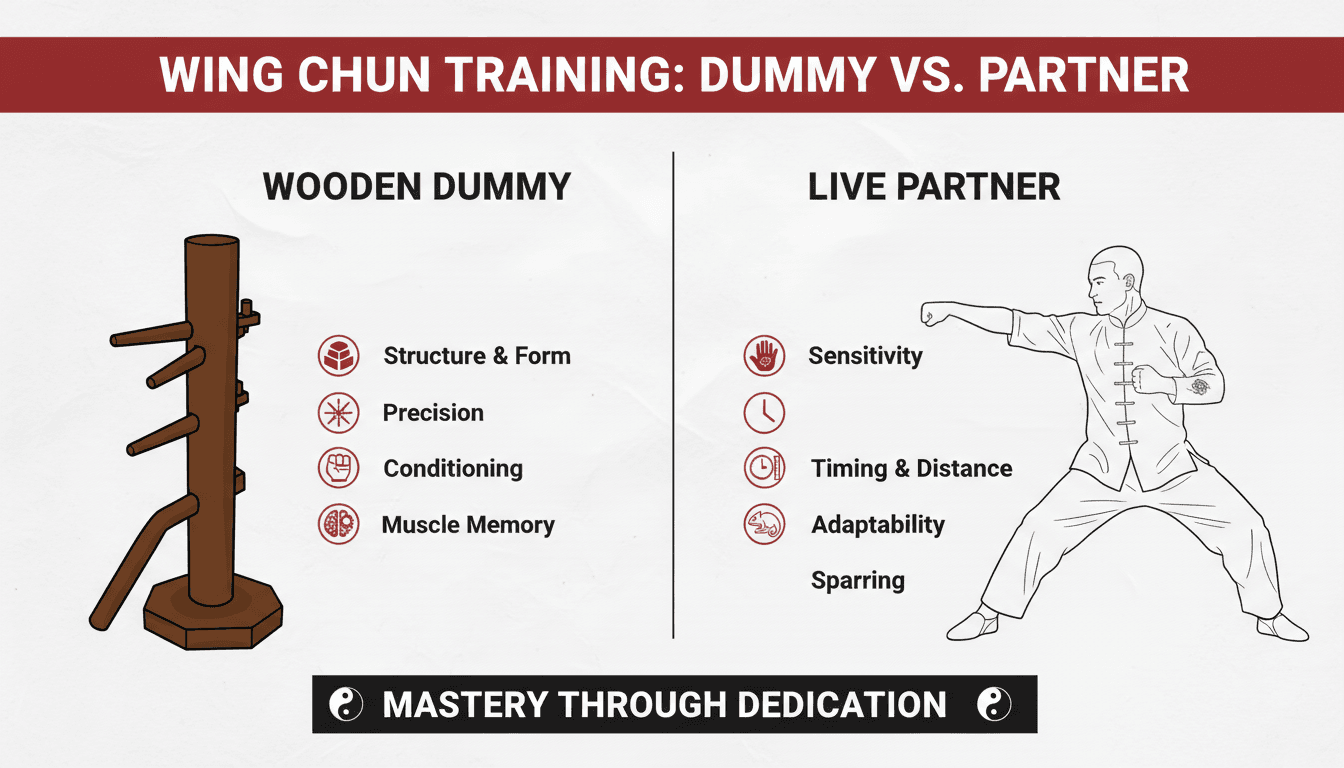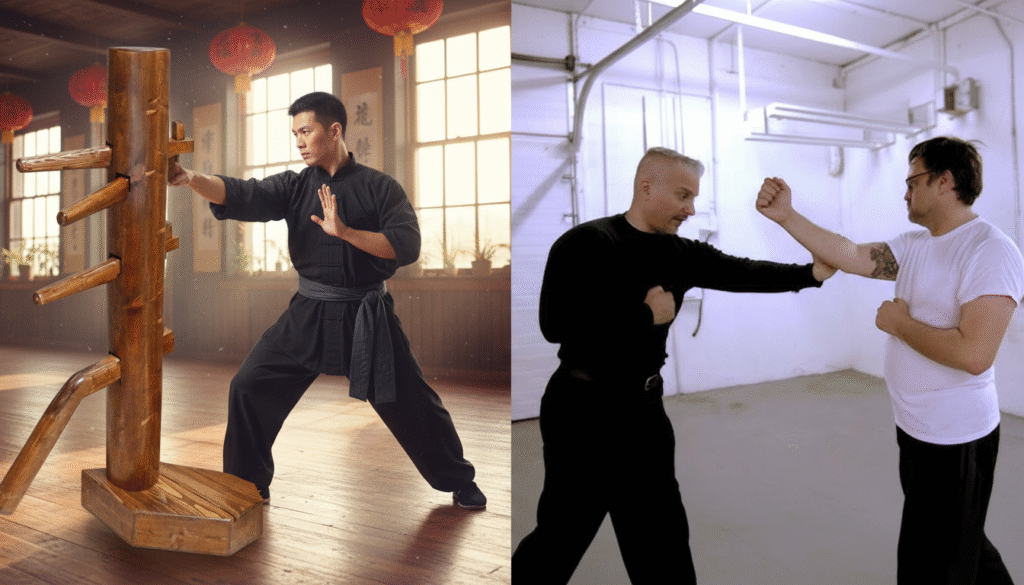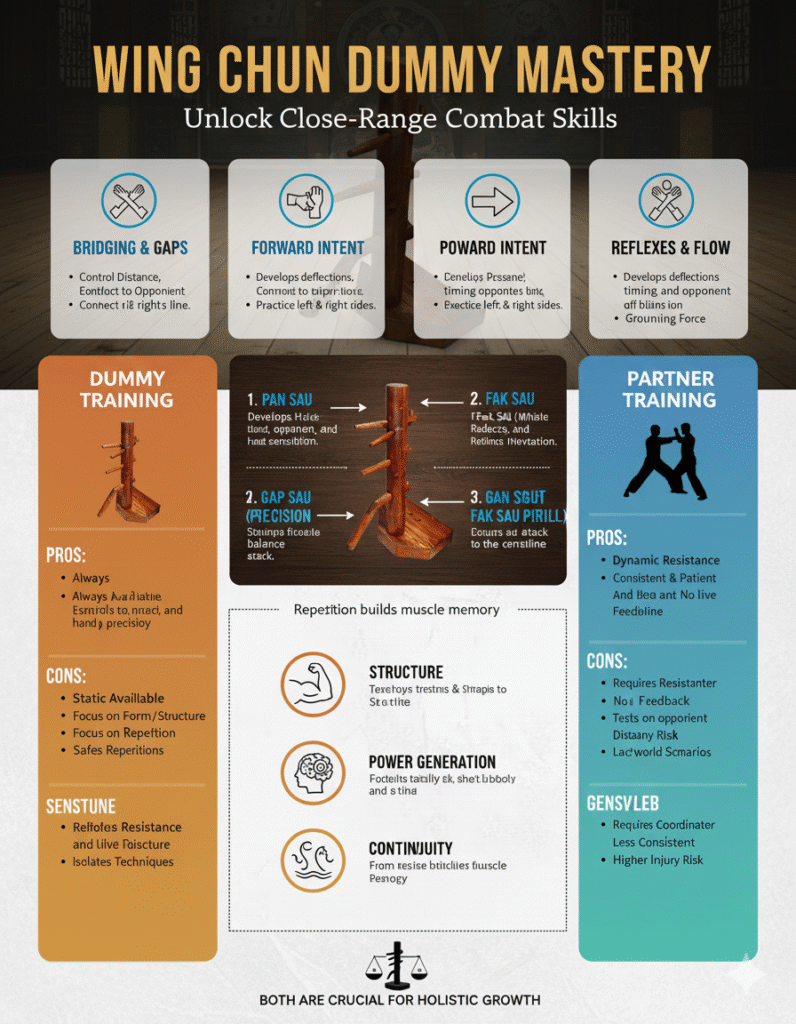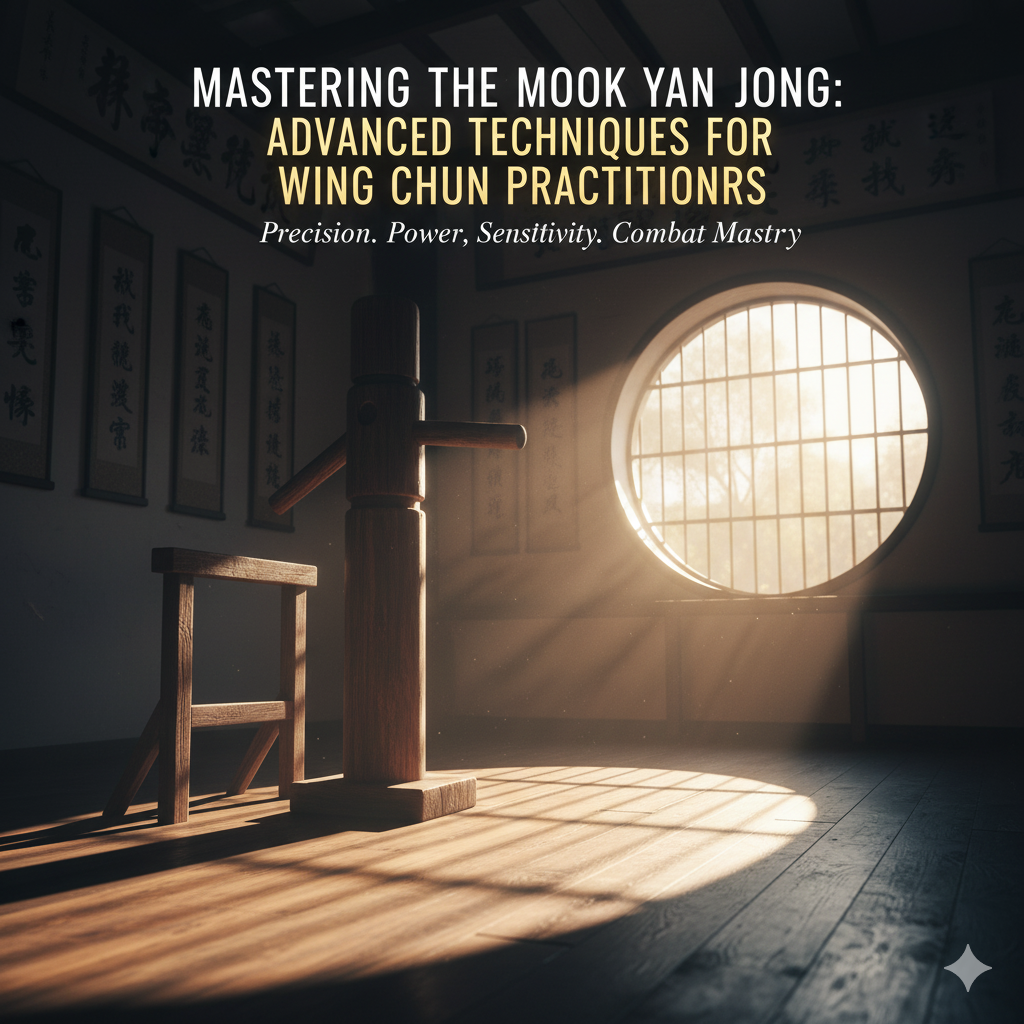Hey there, fellow martial arts enthusiasts!
Today, we’re diving deep into the fascinating world of Wing Chun,
a martial art celebrated for its directness and efficiency.
If you’ve ever considered stepping onto the path of Wing Chun, you know that consistent and effective training is the cornerstone of progress.
But when it comes to honing your skills, two primary methods often come to mind:
the stoic wooden dummy, known as the Muk Yan Jong, and the dynamic, unpredictable live training partner.
Both of these training avenues are integral to a well-rounded Wing Chun practice, yet they offer distinct advantages that cater to different aspects of your development.
It’s not about choosing one over the other, but rather understanding how each complements your journey.
In this comprehensive guide,
we’ll explore the unique benefits of both the wooden dummy and live training,
helping you discover how to integrate them for optimal growth in your Wing Chun journey.
The Wing Chun Wooden Dummy (Muk Yan Jong): Your Silent Teacher

Videos are added as random thoughts 💭 💭 💭.
Imagine a silent, unyielding teacher, always ready to receive your strikes and blocks without complaint.
That’s precisely what the Wing Chun wooden dummy, or Muk Yan Jong, represents.
This iconic training apparatus is a cornerstone of Wing Chun, designed to simulate an opponent’s body and limbs, allowing practitioners to refine their techniques in a controlled environment.
What is the Wooden Dummy?
The Muk Yan Jong is typically crafted from sturdy hardwoods like teak or oak.
It features a cylindrical body with three arms protruding at various angles and heights, mimicking an opponent’s arms in different attack or defense positions.
A single leg extends from the base, designed for practicing sweeps, kicks, and leg blocks.
The dummy is usually mounted on a frame that allows for slight movement, adding a dynamic element that helps you develop a sense of flow and adaptability in your movements.
Key Benefits of Dummy Training:
Training with the wooden dummy offers a multitude of benefits that are crucial for any serious Wing Chun practitioner:
Structure and Form Refinement: The fixed positions of the dummy’s limbs force you to execute techniques with precise body alignment and stance.
This repetitive practice helps ingrain proper structure, ensuring your movements are efficient and powerful.
It’s like having a constant, unbiased mirror reflecting the accuracy of your form [1].
Precision and Timing: Unlike a live partner, the dummy doesn’t move unpredictably.
This consistency allows you to focus intently on the precision and timing of your strikes and blocks.
You learn to hit specific targets with accuracy, developing a keen sense of distance and trajectory.
This precision is vital for effective self-defense, where every inch can make a difference.
Bone and Limb Conditioning: Repeatedly striking the wooden dummy, even with moderate force, gradually conditions your forearms, shins, and other striking surfaces.
This process, often overlooked, toughens your limbs, preparing them for the rigors of real combat.
It’s a form of progressive resistance training that builds resilience and reduces the risk of injury during actual confrontations [2].
Muscle Memory Development: The dummy is an excellent tool for developing muscle memory.
By performing the 108-movement Muk Yan Jong form and various drills repeatedly, your body learns to execute techniques instinctively.
This means that in a high-pressure situation,
your movements will be automatic, allowing you to react without conscious thought,
which is critical when adrenaline is pumping [3].
Spatial Awareness and Angles: Training with the dummy teaches you to understand and utilize angles effectively.
You learn to move around the dummy, finding optimal positions for attack and defense, and developing a heightened sense of spatial awareness.
This ability to control the space between you and an opponent is a hallmark of Wing Chun’s close-range fighting philosophy.
Solo Practice: One of the most significant advantages of the wooden dummy is that it allows for consistent solo practice.
Whether you’re a beginner needing to drill fundamentals or an advanced practitioner refining complex sequences, the dummy is always available.
This accessibility ensures that your training remains uninterrupted, even when a live partner isn’t available, such as during lockdowns or busy schedules [4].
The Live Training Partner: Dynamic and Unpredictable
While the wooden dummy is an invaluable tool for developing foundational skills, Wing Chun is ultimately a martial art designed for real-world application.
This is where the live training partner becomes indispensable.
A human opponent introduces an element of unpredictability, adaptability, and dynamic response that no inanimate object can replicate.
Why Train with a Partner?
Training with a live partner is about bridging the gap between theoretical knowledge and practical application.
It’s where you test your understanding of Wing Chun principles against a moving, thinking, and resisting opponent.
This dynamic interaction is crucial for developing the fluidity and responsiveness needed in actual combat scenarios.
Key Benefits of Partner Training:
Engaging with a live training partner offers a unique set of benefits that are vital for comprehensive Wing Chun development:
Sensitivity (Chi Sao): Perhaps the most unique aspect of Wing Chun partner training is Chi Sao, or “sticky hands.”
This drill develops tactile sensitivity, allowing you to feel and respond to your opponent’s energy, intentions, and movements through physical contact.
It’s a sophisticated form of close-range communication that teaches you to anticipate and neutralize threats before they fully materialize [5].
Chi Sao refines your reflexes and teaches you to maintain control in close quarters, making it a cornerstone of Wing Chun’s effectiveness.
Timing and Distance Management: In a real confrontation, timing and distance are everything.
A live partner constantly changes their position and attacks, forcing you to adapt your timing and manage the distance between you.
This dynamic environment hones your ability to strike at the opportune moment and maintain an optimal range for your techniques.
Without this practice, even the most perfectly executed dummy techniques might fall flat in a real scenario.
Adaptability and Reflexes: No two encounters are ever the same.
A live training partner introduces an element of chaos and unpredictability that forces you to think on your feet and adapt your responses.
This constant challenge sharpens your reflexes, allowing you to react instinctively to unexpected movements, changes in rhythm, and sudden attacks.
It’s about developing a fluid, adaptable fighting style rather than a rigid set of pre-programmed movements.
Sparring and Application: Sparring is the ultimate test of your Wing Chun skills.
It provides a realistic environment where you can apply your techniques under pressure, mimicking the adrenaline and unpredictability of a real confrontation [6].
This is where you discover the gaps in your training, identify what works and what doesn’t, and learn to integrate all aspects of your Wing Chun into a cohesive fighting system.
It’s an essential step for translating theoretical knowledge into practical self-defense capabilities.
Psychological Conditioning: Training with a live partner, especially during sparring, exposes you to the psychological pressures of combat.
You learn to manage adrenaline, maintain composure under stress, and make split-second decisions.
This psychological conditioning builds confidence, resilience, and a deeper understanding of your own reactions in high-stakes situations.
It’s about developing mental fortitude as much as physical prowess.
Feedback and Correction: A live partner provides immediate and invaluable feedback.
They can tell you if your strike lacked power, if your block was ineffective, or if your footwork was off.
This direct, real-time correction is crucial for identifying and rectifying flaws in your technique.
It’s a collaborative learning process that accelerates your development and ensures you’re not practicing mistakes.
Complementary Training: The Best of Both Worlds
It’s a common misconception that you must choose between training with a Wing Chun dummy or a live partner.
In reality, the most effective Wing Chun practitioners understand that these two methods are not mutually exclusive but rather deeply complementary.
They represent two sides of the same coin, each offering unique benefits that, when combined, create a holistic and robust training regimen.
The wooden dummy provides a stable, consistent platform for drilling fundamental techniques, refining structure, and building muscle memory.
It’s where you can meticulously practice your forms, condition your limbs, and develop precision without the pressure of an unpredictable opponent.
Think of it as your personal laboratory, where you can experiment and perfect your movements in isolation.
On the other hand, live partner training,
especially through Chi Sao and sparring, introduces the dynamic and unpredictable elements of real combat.
It’s where you learn to apply the principles and techniques honed on the dummy against a moving, resisting force.
This is where your sensitivity, timing, and adaptability are truly tested and refined.
A live partner challenges your reflexes and forces you to think on your feet, bridging the gap between theoretical knowledge and practical application.
The ideal progression in Wing Chun often involves starting with a strong foundation built on dummy training.
Once your basic structure, techniques, and conditioning are solid, you can then seamlessly integrate partner drills and sparring.
This approach ensures that you have a firm grasp of the fundamentals before attempting to apply them in a dynamic, unpredictable environment.
Without the precision and conditioning gained from dummy work, partner training can quickly devolve into ineffective flailing.
Conversely, without the realism of partner training, dummy work can become a sterile exercise, lacking the vital element of real-world applicability.
Therefore, embracing both the wooden dummy and live training partners is not just an option;
it’s a necessity for comprehensive skill development in Wing Chun.
Each method enhances the other, creating a synergistic effect that accelerates your learning and deepens your understanding of the art.
It’s about building a strong foundation and then testing and refining that foundation against the unpredictable realities of human interaction.
Choosing Your Training Path: When to Focus on Each
Understanding the distinct roles of the Wing Chun dummy and a live training partner is crucial for optimizing your training journey.
The emphasis on each method will naturally shift as you progress through different stages of your Wing Chun development.
For Beginners:
If you’re just starting your Wing Chun journey, the wooden dummy should be your primary focus.
At this stage, your goal is to internalize the fundamental techniques, develop proper body mechanics, and build foundational strength and conditioning.
The dummy provides a patient, consistent, and non-judgmental partner that allows for repetitive drilling and meticulous refinement of your form.
You can practice the Siu Lim Tao and Chum Kiu forms, focusing on precise hand movements, footwork, and structural integrity without the added complexity of an unpredictable opponent.
This dedicated solo practice builds the muscle memory and foundational understanding necessary before engaging in dynamic partner work.
For Intermediate Practitioners:
Once you have a solid grasp of the basics and your techniques feel more natural, it’s time to integrate partner drills into your routine.
This is where Chi Sao becomes incredibly important.
Start with basic Chi Sao drills to develop sensitivity and learn to flow with a partner’s energy.
These drills will help you understand how your techniques translate against a live, albeit cooperative, opponent.
As you progress, you can introduce light, controlled sparring to begin applying your learned techniques in a more dynamic environment.
The goal here is to bridge the gap between the static perfection of dummy training and the fluid reality of human interaction.
You’ll start to see how your precision and structure from dummy work can be adapted and applied in real-time scenarios.
For Advanced Practitioners:
At the advanced level, both the wooden dummy and live training partners remain essential, but the focus shifts.
You’ll continue to refine your advanced dummy forms, using the Muk Yan Jong to perfect intricate combinations and further condition your limbs.
However, a significant portion of your training will be dedicated to dynamic sparring and advanced Chi Sao.
This is where you truly test your adaptability, reflexes, and psychological conditioning against skilled opponents.
The unpredictability of a live partner will push you to react instinctively, manage complex situations, and apply your Wing Chun principles under intense pressure.
Advanced practitioners often use the dummy to troubleshoot specific technical issues identified during sparring, making the two methods a continuous feedback loop for improvement.
Considerations for Solo Practitioners:
Life happens, and sometimes, finding a consistent training partner or attending regular classes isn’t feasible.
This was particularly evident during global lockdowns, where many martial artists found themselves training in isolation.
In such scenarios, the wooden dummy becomes an even more invaluable asset.
While it cannot fully replicate the dynamic nature of a live opponent, consistent dummy training can help maintain and even improve your technical proficiency, structure, and conditioning.
Supplementing dummy work with shadow boxing, visualization exercises, and even online instructional resources can help solo practitioners continue their Wing Chun journey effectively.
Remember, any training is better than no training, and the dummy provides a reliable means to keep your skills sharp until you can resume partner work.
Conclusion
In the world of Wing Chun, the debate between the wooden dummy and a live training partner is not about choosing a superior method,
but about embracing a holistic approach to training.
Both the Muk Yan Jong and a live partner offer unique, indispensable benefits that contribute to a well-rounded and effective Wing Chun practice.
The wooden dummy is your silent, patient teacher, providing the perfect platform to build a strong foundation.
It’s where you refine your structure, perfect your techniques, and condition your body for the rigors of combat.
It’s the bedrock upon which your Wing Chun skills are built.
A live training partner, on the other hand, is your dynamic, unpredictable sparring mate.
It’s where you test your skills in a real-world context, developing the sensitivity, adaptability, and psychological fortitude needed for effective self-defense.
It’s the crucible where your theoretical knowledge is forged into practical ability.
Ultimately, the journey of a Wing Chun practitioner is one of continuous learning and refinement.
By integrating both the wooden dummy and live training into your regimen,
you create a powerful synergy that accelerates your growth and deepens your understanding of this profound martial art.
So, embrace both your
silent teacher and your dynamic sparring partner, and watch your Wing Chun skills flourish.



